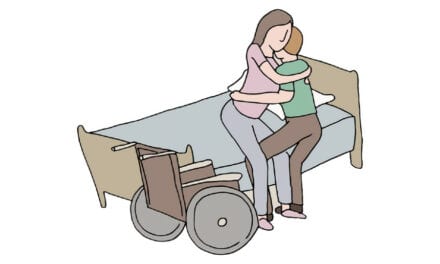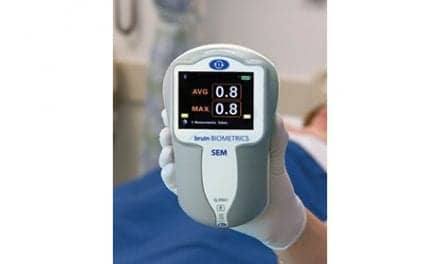An interdisciplinary approach in which clients and caregivers participate helps make homes fall-safe and secure
by John Rider, MS, OTR/L, MSCS, CEAS
Falls are the leading cause of fatal and nonfatal injuries among older adults.1 One in four adults over the age of 65 fall each year, and only half of those that fall discuss it with their healthcare provider.1 Although these statistics are alarming, falls are not an inevitable part of aging. Occupational therapists (OTs) and physical therapists (PTs) can play a crucial role in reducing fall risk in all settings of rehabilitation, including the home. Community-based OTs and PTs have the unique opportunity to be in the home with clients and provide customized home modification recommendations for fall prevention.
In the April 2020 issue of Rehab Management, Katherine Howe highlighted how OTs and PTs working in any rehabilitation setting could leverage their clinical experience with additional training to become home modification consultants. This article highlights how OTs and PTs can utilize evidence-based home modification recommendations to help clients reduce falls and increase independence and safe access to their home environment.
Fall Risk Factors
It is accepted that falls result from interactions among multiple risk factors derived from intrinsic, extrinsic, or behavioral origins.2 Although this article focuses on extrinsic fall risk factors in the home, OTs and PTs must be aware of and address intrinsic and behavioral risk factors. Intrinsic factors are dynamic; they change over time and typically refer to individual risks, such as health conditions, degrees of functional impairment, or states of being.
Behavioral fall risk factors reflect how individuals choose to interact in their environment. For example, individuals may choose to engage in unsafe activities (eg, walking with poor footwear in the home, standing on a stool to change a light bulb, not using grab bars or a shower chair, etc), despite skilled education from therapists. Extrinsic risk factors, which are the focus of the remainder of this article, are environmentally oriented and shared among individuals who inhabit a common environment (eg, loose throw rugs, uneven surfaces, poor lighting, etc).
Since fall risk factors are diverse, the best approach is to assess, identify, and address all factors that increase an individual’s risk for falls. The research is clear that multifactorial fall-prevention programs are significantly better at reducing falls than unifactorial approaches.3 Although home modifications have been shown to reduce falls, they are only one piece of the puzzle as more older adults choose to age in place and individuals return home after significant health events.
Recommending Home Modifications
Making recommendations for home modifications may seem daunting to many therapists. A quick search online provides many different home safety evaluation tools that vary with respect to length, complexity, time to administer, resources needed, and required training. Although multiple assessments exist to guide the home evaluation, the groundwork for all home safety evaluations is rooted in identifying potential hazards. The simplest home safety evaluations involve checklists that help identify the most common hazards. Many of these are free and can be used to help guide the home safety evaluation and initiate discussion of hazards and potential solutions with clients. These checklists vary significantly concerning their comprehensiveness and cannot replace a skilled therapist’s clinical reasoning.
Home safety evaluations should be approached with both universal design and a client-centered perspective. There are many principles of home safety that fall under the umbrella of universal design, or sometimes called barrier-free design, and focus on making the house safe and accessible for everyone, regardless of age, physical ability, etc. With that said, OTs and PTs have always recognized the importance of client-centered care and providing targeted recommendations for each client. Optimal home safety evaluations will include both perspectives of universal design and client-centered recommendations. In addition, therapists should observe how the client interacts with their environment naturally and have a candid discussion about what type of modifications they are willing and able to make.
Home modification recommendations can be grouped into at least four categories: additive, subtractive, transformative, and behavioral.4 Additive modifications include major and minor additions to the home, and by contrast, subtractive modifications involve removal of items or hazards; both recommendations aim to improve safety and access to the environment. Transformative modifications involve a significant restructuring of the existing home to facilitate the use of environmental features. Behavioral modifications, which are commonly considered adapted or compensatory techniques, include avoiding or adopting specific behaviors to improve safety.
Therapists can use this categorization system to provide clear recommendations and discuss the cost-benefit analysis with clients. For example, subtractive modifications, such as the removal of an older throw rug, can decrease fall risk and require no cost. This change may seem small to the therapist, but could be monumental for the client if there is sentimental value to the rug. On the other hand, a transformative modification, such as widening a doorway to improve accessibility for individuals who may require the use of a wheelchair, could potentially be costly and require the services of a general contractor. Below are some examples of typical home modifications shown to reduce fall risk and improve safe access during activities of daily living.
Additive
• Install support items such as handrails and grab bars in high-risk areas (eg, entrances, stairs, bathtubs, showers, and toilets)
• Install night lights or motion sensor lights to improve lighting in common pathways (eg, from the bed to the bathroom, dark hallways, the garage, or the front porch)
• Place non-skid mats, strips, or carpet on slippery surfaces (eg, bathtubs, showers, outside steps or porches)
• Add high-visibility edging for steps and threshold transitions
• Install temporary or prefabricated ramps to compensate for minor thresholds at entrances
• Install carpet trims to prevent carpet edges from fraying and ensure a smooth transition between carpet and other flooring
Subtractive
• Removing tripping hazards (eg, loose throw rugs, clutter, electrical cords, animal beds or food/water bowls, etc)
Transformative
• Rearrange large furniture to clear pathways and provide more effortless movement around the house
• Relocate frequently used objects, such as cooking utensils, cleaning supplies, or food items, so they are within safe reach
• Install modified door systems such as automatic door openers or closers, to make it easier to open and close doors
• Install permanent ramps at entrances where stairs or significant thresholds may be present
• Remodel the bathtub or shower to create a curbless, roll-in shower, or walk-in tub for safer access
Behavioral
• Modify a room for sleeping on the first floor instead of the second floor for individuals unable to use stairs safely
• Identify friends, family, neighbors, or community services to assist with daily activities that the individual cannot perform safely in the home (eg, hiring a cleaning service or a handyman to change light bulbs)
• Adopt new methods of getting in and out of high-risk places in the home (eg, bathtubs, showers, garages, etc)
In addition to general fall prevention for aging adults, many older adults must consider significant home modifications with unexpected neurological or orthopedic impairments. Returning home after a significant health event or inpatient rehabilitation can be a scary process, even with supportive family and friends. Depending on the rehabilitation prognosis, a combination of all four types of home modifications may be necessary.
Tailored to Taste
Below are some additional home modifications to consider for clients returning home after significant health events.
For example, when returning home with a wheelchair, the therapist and client should consider the need for ramps where stairs or significant thresholds are present. There are many portable ramps, made of steel, aluminum, and even rubber. Threshold ramps are generally cheap and easily installed when the only obstacle is a threshold up to 4 inches high. Many types of portable ramps exist with an anti-slip backing, so they don’t need to be screwed into steps or doorways. This option may be best for individuals renting or concerned about making permanent changes. These ramps usually fold up and can be taken other places when needed.
Portable ramps can also be secured into the door frame for more permanent use. If multiple steps exist and a permanent ramp is necessary, the best option is to work with a general contractor. Search around the area as many nonprofit organizations exist to help with medically necessary transformative home modifications.
Stair lifts are another transformative modification that can provide safe access to multi-level homes. Stair lifts are a more costly expense; however, if the client wishes to remain in their home and utilize multiple levels, it may be the best option. Today’s stair lifts can be installed with no structural changes in as little as a day. This type of modification will require working with a company that manufactures and/or installs stair lifts. The best approach is to find a company that services the client’s area, schedule a no-cost consultation, and work with the installer to ensure your client can safely use the stair lift.
Patient lifts are another option for clients with severely limited mobility and caregivers unable to transfer their loved ones safely. Patient lifts are either manual or power lifts that decrease the effort of the caregiver when helping the client reposition in bed, get up from a surface, stand, or transfer from one surface to another. Lifts can be considered transformative and installed directly on the ceiling with tracks going throughout the home, or they can be additive, with a rolling lift being pushed wherever needed.
Various slings are available for different sized individuals and different functional purposes. You will need to consider client’s current functional status and prognosis, height, weight, range needed (eg, how low and how high does the client need to be lifted), emergency features, a built-in scale, available space in the home, financial considerations, and caregiver abilities when deciding on the type of lift and sling.
Therapists can also recommend everyday adaptive equipment, such as adaptive dressing items, durable medical equipment, such as tub transfer benches or shower chairs, smart home devices, and emergency alert systems to improve safety, independence, and emergency preparedness. Home modifications for fall prevention require an interdisciplinary approach, with expertise and input from all providers, including the client and caregivers. We live in a time where the availability of home modifications is always increasing, and more items can be shipped to remote areas. OTs and PTs must keep up to date with advances in technology and current evidence to know what home modifications are available and most effective. We have the knowledge and skills to help individuals of all ages and abilities remain safely in their homes. RM
John (Johnny) Rider, MS, OTR/L, MSCS, CEAS, is an assistant professor at Touro University Nevada. He is completing his PhD in interdisciplinary health science with an emphasis on rehabilitation science from the University of Nevada, Las Vegas. He has practiced in multiple settings and across the lifespan but is most passionate about home and community-based rehabilitation. For more information, contact [email protected].
References
- Bergen G, Stevens MR, Burns ER. Falls and fall injuries among adults aged [greater than or equal to] 65 years–United States, 2014. MMWR Morb Mortal Wkly Rep. 2016;65(37):993–998. https://www.doi.org/10.15585/mmwr.mm6537a2
- Pynoos J, Steinman BA, Nguyen AQD. Environmental assessment and modification as fall-prevention strategies for older adults. Clin Geriatr Med. 2010;26:633–644.
- Hopewell S, Copsey B, Nicolson P, Adedire B, Boniface G, Lamb S. Multifactorial interventions for preventing falls in older people living in the community: a systematic review and meta-analysis of 41 trials and almost 20 000 participants. Br J Sports Med. 2019. https://www.doi.org/10.1136/bjsports-2019-100732
- Steinman BA Nguyen AQD. (2011, November). Outcome analysis of the InSTEP home modification component Symposium. Gerontological Society of America. Boston.





